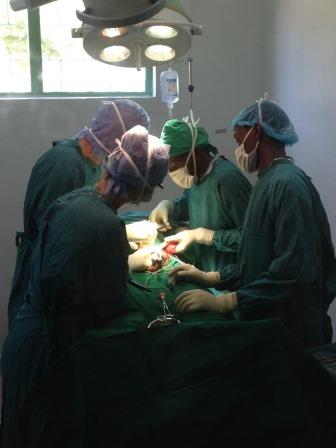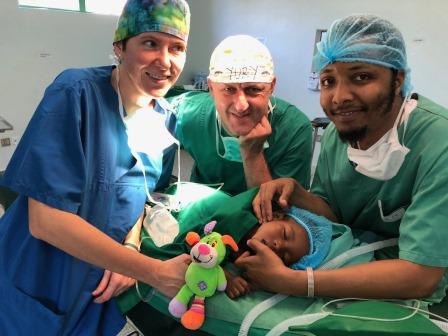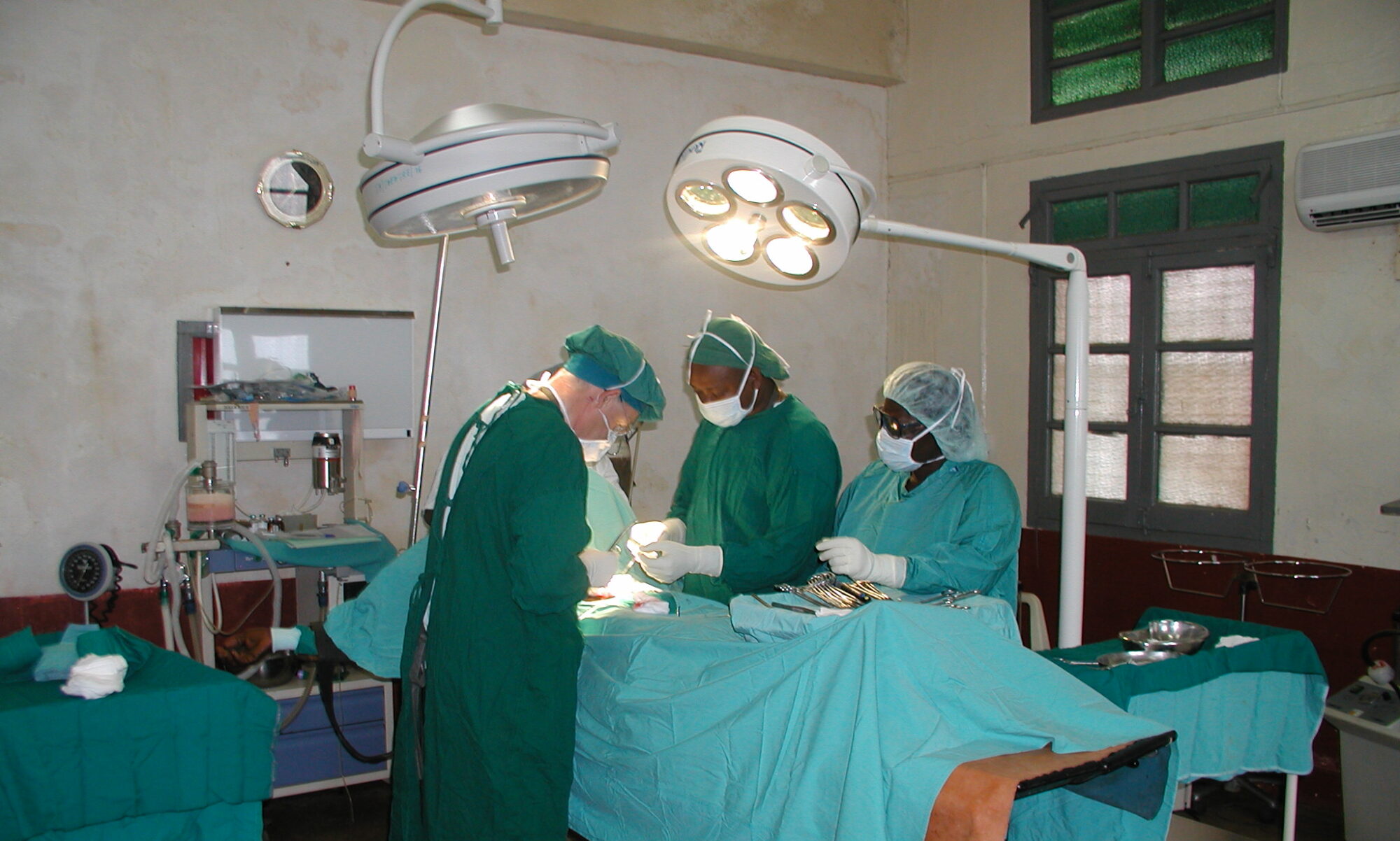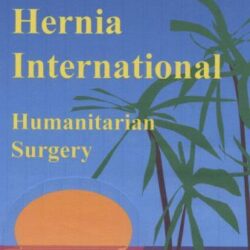TANZANIA 2 0 1 9
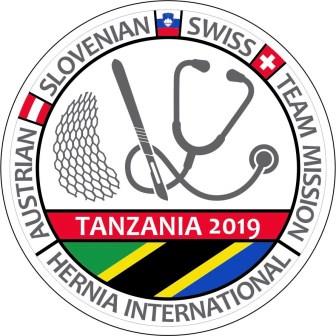
Austrian-Slovenian-Swiss
“Hernia International” Team
Mission in
Momella, November 4th-10th 2019
Africa Amini Alama – AAA (www.africaaminialama.com) is a charitable hospital, located on the tableland between Mt. Meru and Mt. Kilimanjaro in Northern Tanzania. The name AAA means “place of trust in the future of Africa” or also “Africa, we believe in you”.
The organization was founded by Christina Wallner und Cornelia Wallner-Frisee just 11 years ago. After Austrian radiologists, like dr. Celedin, made contacts to the organization and donated some devices, we were encouraged to start the cooperation between Hernia International (HI) and AAA. This first “inspective” mission consisted of experienced HI specialists in order to treat as many patients as possible, but also to check the possibility for further cooperation.
Our team consisted of 8 members: surgical consultants Christoph Sträuli and Jurij Gorjanc , surgical resident Lara Maniglio, anesthetist Katharina Wentkowski, gastroenterologist/endoscopist Klemen Mojškerc, anesthetic/theatre nurse Petra Koch, medical device expert Michael Wentkowski, medical device expert assistant Alex Koch.
Good communication between our team and Mag. Dr. Cornelia Wallner-Frisee started almost 1 year ago and the mission was well prepared. All our patients were treated free of charge exclusively on humanitarian basis. The hospital is compared to African standards surprisingly well equipped. They even started to perform basic laparoscopic operations and we also performed 1 laparoscopic appendectomy with very elementary equipment that we intend to improve.
Experienced anaesthesiologist Katharina performed general and spinal anaesthesia to both operating tables while teaching the two local anesthetic nurses. Alan and Fanuel are very experienced in spinal anesthesia already. Training concentrated on safe general anesthesia in children, low flow technique to reduce the use of anesthetic gas and regional plexus techniques. Nurse Petra was of great help in anesthesiology and surgery. In addition she trained the local theatre nurses in hygiene standards. Christoph and me enjoyed performing surgery as well as educating talented Lara and local surgeons Dr. Kombo and Dr. Sebastian. Dr. Kombo is already very independent in various procedures as a young consultant and Dr. Sebastian has indeed a fine feeling for surgery. The majority of patients had hernias and hydrocaeles. Michael and Alex repaired the sterilizer, diathermy machine, CO2 regulator, endoscopy and laparoscopy monitor and many more. In addition they organized a 4-days hands-on workshop to train local engineers in maintenance and repair of medical devices. Excellent endoscopist Klemen brought the endoscopy in the hospital to a higher level, also performing some polypectomies.
Our team did not meet before but as Dr. Wallner-Frisee stated, we worked together as if we have known each other for a long time. We started surgery at 8.30 in the morning, had a lunch break in the hospital restaurant and then proceeded with surgery and recruiting new patients on the ward till sunset.
Good work in the hospital was also possible because we were accommodated very well in the Lodges Nature Homes and Hillside Retreat. There is basic accommodation available on the hospital campus as well, but it was already occupied by other volunteers.
Thursday afternoon we visited a Massai boma in the evening. On Saturday (after finishing work) the whole team walked and drove through the nearby Arusha National Park.
Statistics on 32 patients (36 procedures):
Children…………………………………………………….6 Pts (18%)
Women……………………………………………………………8 Pts (25%)
Inguinal hernias…………………………………………….…20 Pts (62%)
Incisional, epigastric, umbilical hernias……………..8 Pts (20%)
Other diagnoses (appendicitis, foreign body)………2 Pts (6%)
In children the inguinal hernias were repaired with Mitchell Banks technique, with or without fascia closure, according to age, respectivelly. Suture repair was used in children with umbilical hernias. In teenagers, Shouldice technique was instructed and local surgeons loved to learn this approved meshless technique. In incisionals, epigastric and umbilical hernias in adults, sublay repairs were performed with LDPE and PP-mesh. Surgery was performed in spinal anaesthesia (20 Pts) and general anaesthesia (12 Pts).
Additional work:
Gastroscopies…………………………………….……..10 Pts
Colonoscopies…………………………………………….3 Pts
OPD…………………………………………..daily up to 30 Pts
Repaired machines and devices:
Autoclave for theatre…………………………………………1
Diathermy machine……………………………………………2
Laundry machine………………………………………………1
Refractometer/Optimetry……………………………………..1
CO2 monitor……………………………………………………..1
Anaesthesia gas monitor……………………………………..1
Endosopic camera color adjustment……………………….1
Perfusomat………………………………………………………1
Electromyography and stimulator device………………….1
Invasive plexus stimulator…………………………………….1
Colorimetric blood analyzer…………………………………..1
General training for local engineers (electricians, car mechanics, carpenters)
Topics: Types and composition of medical devices (diagnostic, surgical, therapeutic, invasive versus non-invasive). Electrical and biohazard safety measures, electrical characteristics, general main power concept and safety checks, typical maintainance tasks, systematic disassembly and assembly devices, testing procedures and strategies to detect typical failures.
Our team:
Christoph Sträuli – consultant surgeon, Switzerland
Jurij Gorjanc – consultant surgeon, Austria (team leader)
Katharina Wentkowski, consultant anesthetist, Switzerland
Klemen Mojškerc, consultant gastroenterologist, Slovenia
Lara Maniglio, resident in surgery, Switzerland
Michael Wentkowski – medical engineer, Switzerland
Petra Koch, DGKS – Austria
Alexander Koch – Austria
Report written by:
Jurij Gorjanc, MD, PhD, General Surgeon
Hospital of St. John of God, St. Veit/Glan
(Krankenhaus der Barmherzigen Brüder)
Austria
Our sponsors:
Kirurgija Bitenc
Splosna bolnisnica / General Hospital Slovenj Gradec
Implantoloski institut / Implant Institute
University clinical centre Ljubljana
Medical center Gorjanc
Hospital of St. John of God St. Veit/Glan
